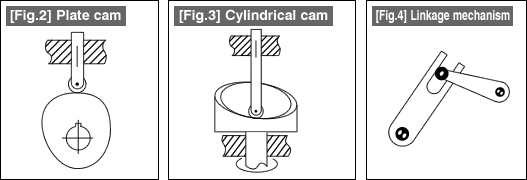#026 The Flow of Low Cost Automation (LCA) Concept - 1 : The Flow of Mechanical LCA
LCA second generation
An LCA element "Mechanical cam/link mechanism" appeared as schemes to repeatedly produce mass quantities of goods (Ford-ism) developed.
This was an advancement from the first generation LCA elements of rotary to linear motion conversion to use as labor, and the advancement was based on the human dexterity rules replaced with cams and linkages to achieve two and three dimensional motion control.
| The cam mechanism was already in existence in Leonardo da Vinci's sketch (see Fig.1). Thereafter, it was used for a variety of decorative wood working tools, then the scheme's high speed and reliability performance were further pursued for textile machinery and internal combustion engines in 1900s. Later, with the advent and advancements of NC machine tools, manufacturing of cams and linkages that are capable of complicated motion control tasks became possible, and became an important element of mass production assembly machinery. | ![[Fig.1] Sketch of Leonardo da Vinci's cam mechanism](http://www.misumi-techcentral.com/tt/en/lca/images/026_1.gif) |
The mechanical cam/linkage mechanism is an important element of the LCA concept due to its advantages such as stable and fast work handling capabilities for pick and place machines and indexing tables, and even for the most advanced surface mount machines for electronic components.
Advantages of the mechanical cam/linkage mechanism
| 1. | Deceleration shock can be minimized by a cam curve thus high speed operation is possible. | |
| 2. | Multiple motion tasks can be controlled simultaneously thus the machine cycle time can be shortened. | |
| 3. | Machine size and low parts count result in good system stability and maintainability. |
Examples of "Mechanical cam/linkage mechanism"

- Positioning technology
- Designing and processing
- Sensor Technology
- Automation elements technology
- Clean room technology
- Design hints
- Design tips
- Designing and Machining
- Drive mechanism design
- Hints on designing
- Linear Motion Components
- Locating Technology
- Manufacturing technology
- Motion mechanism design
- Pneumatic Drives
- Production Technology
- Technology Outlook
- General description
- Low-cost automation and materials
- Transfer LCA
- #333 Know-how on automation: Pressurized heating technology - 5: Multilayer pressurized heating process technique
- #332 Know-how on automation: Pressurized heating technology - 4: Points to remember when designing mechanism of pneumatic pressurization method
- #331 Know-how on automation: Pressurized heating technology - 3: Pneumatic pressurization method and pressure profile
- #330 Know-how on automation: Pressurized heating technology - 2: Pressurization method and pressure profile
- #329 Know-how on automation: Pressurized heating technology



